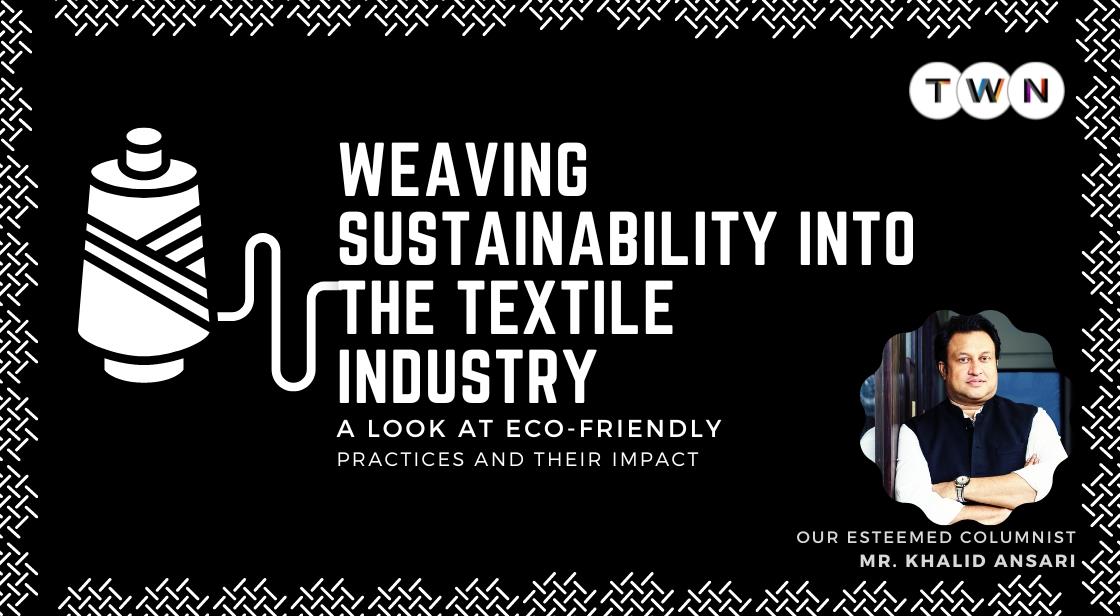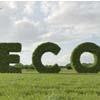Weaving Sustainability into the Textile Industry: A Look at Eco-Friendly Practices and their Impact

Blog Post
Welcome to a world where the textile industry is undergoing a remarkable transformation, driven by a growing awareness of its environmental impact and the urgent need for sustainable practices. For far too long, the textile industry has been associated with pollution, resource depletion, and waste generation. However, a new era is dawning, where sustainability is becoming a core value, and eco-friendly practices are being woven into the fabric of the industry.
This paradigm shift is driven by a collective realization that traditional manufacturing methods are no longer viable in a world facing climate change and ecological challenges.
The textile sector has embraced the green revolution, recognizing that the future lies in sustainable, earth-friendly textiles rather than synthetics. Through innovation, collaboration, and a deep commitment to change, the industry is reinventing itself, one stitch at a time.
At the heart of this transformation is the understanding that responsible textile production is not just an option; it's a necessity. Consumers are becoming more enlightened, demanding products that align with their values and commitment to the environment.
As a result, brands and manufacturers are compelled to reevaluate their practices, reimagine their supply chains, and reinvent their business models.
The green makeover of the textile industry encompasses various dimensions of sustainability. Material sourcing plays a crucial role, with brands increasingly opting for organic fibers, recycled materials, and plant-based dyes.
These alternatives provide viable options to synthetic fibers and harmful chemical dyes, reducing the industry's impact on the environment.
Beyond its own boundaries, the transformation of the textile industry is creating ripples across sectors and inspiring a global green movement. As one of the largest contributors to environmental degradation, the industry's commitment to sustainability sets an example for others to follow. It challenges businesses in all sectors to reconsider their environmental footprints, driving innovation and change on a larger scale.
While the journey towards a fully sustainable textile industry is ongoing and challenges remain, every eco-friendly thread spun and every meter of sustainable fabric woven brings us closer to a greener future.
The textile industry's green revolution is not just a trend; it's a powerful testament to the potential of sustainable practices. It demonstrates that businesses can thrive, not just survive, by embracing environmental responsibility and meeting the evolving demands of conscious consumers.
In this blog, we will explore the intricacies of the textile industry's sustainable transformation. We will delve into the latest innovations, best practices, and success stories that are reshaping the industry.
From organic cotton to recycled polyester, from zero-waste design to eco-friendly dyeing techniques, we will uncover the strategies and initiatives that are redefining the very fabric of sustainability in the textile industry.
Join us on this inspiring journey as we celebrate the positive changes happening in the textile sector and envision a future where fashion and sustainability go hand in hand. Together, we can weave a brighter, greener, and more sustainable world, one garment at a time.
------------------------------------------------------------------------------------------------------------------------------------------------------------------------------------------------------------------------------------------
We are privileged to present this special article written by our esteemed columnist, Mr. Khalid Ansari. As a highly regarded figure, Mr. Ansari brings his unique insights and expertise to our readers. His profound knowledge and experience in various industries, including Textile & Fabric Manufacturing, make his contributions invaluable.
We encourage our readers to stay connected with Mr. Khalid Ansari by following him on these social media platforms:
Facebook : https://www.facebook.com/khalidunplugged
Twitter: https://twitter.com/khalidunplugged
Imstagram: https://www.instagram.com/khalidansariunplugged/
Linkedin: https://www.linkedin.com/in/khalidansariunplugged/
Imagine a world where your favorite pair of jeans or that uber-soft cotton tee you simply can't part with are no longer the baddies in a story about environmental degradation. The textile industry, long known for its less-than-stellar environmental footprint, is finally getting a green makeover.
Weaving sustainability isn't just a catchy phrase. It's an eco-friendly revolution transforming the textile sector, stitch by stitch, into a beacon for sustainable practices.
"The fabric of our future lies not in synthetics, but in sustainable, earth-friendly textiles."
Join us as we unravel the threads of this story, examining how the industry is embracing eco-friendly practices, driving sustainability, and impacting the global green movement. If you've ever wondered about the journey your clothes take from field to hanger, this is a read you won't want to skip.trailblazing change, one stitch at a time
Revolutionizing the Textile Industry: A Comprehensive Look at Sustainable Practices
Ever heard of the saying, "old ways won't open new doors"? Well, the textile industry seems to be taking this to heart and saying goodbye to traditional manufacturing methods. They're embracing the green revolution head-on, weaving sustainability right into the fabric of their business models.
"The global market for sustainable textiles is expected to reach $9.81 billion by 2025."
Why the Shift?
It's no secret that the textile industry has been a significant polluter. The resources it consumes, the waste it generates, and its carbon footprint have been causing alarm bells to ring around the globe. Today, however, responsible textile production is no longer an option – it's a necessity.
The industry is stepping up to meet the increasing demand for sustainable products. Consumers are more enlightened and, importantly, willing to make choices that reflect their commitment to the environment. This shift is driving the industry to reevaluate, reimagine, and reinvent its practices.
The Green Makeover
So, what does this green makeover look like? It's about adopting practices that minimize environmental impact, promote social responsibility, and still deliver products that meet consumers' expectations.
-
Material Sourcing: Increasingly, brands are opting for organic fibers, recycled materials, and plant-based dyes. This provides a viable alternative to synthetic fibers and harmful chemical dyes.
-
Water Conservation: Innovative technologies are being implemented to reduce water use in production processes. New dyeing techniques, for example, can save up to 80% of water.
-
Energy Efficiency: From solar-powered factories to energy-efficient machinery, the industry is making strides in reducing its energy consumption.
The Ripple Effect
The transformation of the textile industry is creating ripples beyond its boundaries. It's influencing other sectors to consider their environmental footprints and inspiring a global green movement.
No, the journey isn't easy, and full-fledged transformation will take time. However, every eco-friendly thread spun, every meter of sustainable fabric woven, brings us one step closer to a greener future.
Indeed, the textile industry's green revolution is a testament to the power of sustainable practices. It proves that businesses can thrive, not just survive, by going green. And that, dear readers, is a trend worth celebrating.
From organic cotton to recycled polyester, innovative materials are paving the way. Cutting-edge technology is facilitating water conservation in dyeing processes. These eco-friendly practices are not just transforming the textile industry, they are redefining the very fabric of sustainability.
Going Green: The Future of Fashion and Textile Production
Step aside, fast fashion. The new vogue in town is ‘green.’ The textile and fashion industry, once notorious for its unhealthy love affair with pollutants and waste, is now embracing sustainability like never before. This dramatic transformation is not just a fad, but a necessary stride towards a more sustainable future.
Embracing Sustainable Materials
The world is brimming with innovative, eco-friendly materials that are whispering sweet nothings to the textile industry. Bamboo, hemp, organic cotton, and recycled polyester are just a few examples. These materials are not only kinder to the Earth, but also create high-quality textiles perfect for the discerning fashionista.
The Power of Zero-Waste Design
Of all the fresh trends in the textile industry, zero-waste design is perhaps the most transformative. This approach aims to create clothing that generates no leftover material during production. Waste is effectively slashed to zero, transforming the way the industry operates one garment at a time.
Colouring the World Green with Eco-Friendly Dyes
Chemical dyes are out; natural, eco-friendly dyes are in. More and more textile manufacturers are swapping hazardous chemical dyes for safer, greener alternatives derived from plants, insects, and sometimes even food waste. The result? A splash of sustainable colour on the fashion canvas.
To sum up, the textile industry's journey from being a major polluter to an advocate for sustainability is one for the books. It's a transformation that's still unfolding, with many exciting developments on the horizon. So, the next time you don a new piece of clothing, take a moment to think about its journey. Because the future of fashion and textile production is undoubtedly green.
Sustainability as a Competitive Advantage in the Textile Industry
sustainability in the textile industry isn't just a buzz-word or a PR move. It's becoming a competitive advantage that is driving innovation and market share. More and more, consumers are aligning their purchasing decisions with their values, and a commitment to the environment is high on the list.
For companies in the textile industry, this shift in consumer behavior is an opportunity to stand out. By adopting eco-friendly practices, they can resonate with consumers, gain their trust, and build brand loyalty. Let's look at how this transformation is taking place.
"The textile industry is the second largest polluter in the world"
Greening the Supply Chain
From raw materials to manufacturing processes, companies are scrutinizing every step of their supply chain for opportunities to reduce their environmental footprint. Some are turning to organic cotton, others are using recycled materials, and many are investing in energy-efficient technologies.
-
Organic cotton involves farming practices that don't rely on toxic pesticides and synthetic fertilizers. It's not only better for the environment, but also for the farmers' health and the end consumers.
-
Recycled materials help to reduce waste and conserve natural resources. Some textile companies are even launching take-back programs, encouraging customers to return their old clothes for recycling.
-
Energy-efficient technologies in manufacturing processes can drastically reduce carbon emissions. This is a significant step forward, considering that the textile industry is one of the biggest contributors to global greenhouse gas emissions.
Driving Sustainability through Innovation
While these are important steps, the truly transformative change is happening through innovation. Companies are exploring new materials and manufacturing processes that not only reduce their environmental impact, but also improve the quality and functionality of their products.
For instance, some are experimenting with bio-fabrication - creating materials in a lab instead of a farm or a factory. Others are using 3D printing to produce clothes with zero waste. These ground-breaking practices are a testament to how the textile industry is weaving sustainability into its competitive strategy.
Sustainability is more than just a trend in the textile industry. It's a strategic move that benefits the companies, their customers, and the planet. And it's a narrative that more companies need to adopt, to ensure a greener future for all.
"20% of global industrial water pollution comes from textile dyeing and treatment."
Eco-friendly Textile Dyeing Techniques You Need to Know
Picture yourself in a world where fashion doesn't cost the earth - literally! It's a world where vibrant hues and trending styles are born from eco-friendly dyeing techniques. The textile industry is undergoing a green revolution, and it's a technicolor dream.
Plant-Based Dyes: Back to the Roots
Remember when your grandmother used turmeric to stain her fabrics yellow? Welcome to the world of plant-based dyes, where spinach imparts a verdant green and beetroot bathes cloth in a romantic red. Derived from nature, these dyes are biodegradable and non-toxic, making them a sustainability champion in the textile industry.
Low Water Immersion Dyeing: Less is More
Imagine dyeing fabric but using less water. That's what low water immersion dyeing is all about. By using minimal water and maximising dye absorption, this technique significantly reduces water wastage. It's a small step towards a greener planet, but with big impacts.
Recycled Dyeing: Waste Not, Want Not
What if we could recycle waste into something beautiful? Meet recycled dyeing. This ingenious method transforms textile waste into vibrant dyes, promoting a circular economy. Not only does this technique breathe new life into waste materials, but it also slashes the carbon footprint of the textile production process.
In the heart of the textile industry, a revolution is brewing. As we weave sustainability into our practices, we're not just creating a greener industry - we're creating a greener world. So next time you don a chic scarf or a trendy tee, remember: you're wearing a piece of that revolution. And trust me, it looks good on you.
"The industry is responsible for 10% of global carbon emissions"
Recycling Textiles: A Sustainable Solution for a Growing Problem
Imagine a world where each piece of clothing you discard gets a second life. Sounds amazing, right? Welcome to the exciting world of textile recycling. It's a game-changer for the fashion industry and a lifeline for our planet.
Textile recycling is a smart and efficient way to tackle the increasingly gnawing issue of textile waste. In essence, it's about repurposing or reusing old or waste textiles, turning them into valuable and sustainable resources. This kind of creativity is not just eco-friendly; it can also help to reduce the pressure on natural resources.
The Magic of Textile Recycling
It's mind-boggling to think about the transformation that happens in textile recycling. A discarded t-shirt, for instance, can become insulation material for a home, a new rag, or even the cozy filling inside your pet's bed. It's magical, eco-friendly, and a testament to the old adage: One man's trash is another man's treasure.
Textile Recycling: A Win for Businesses and the Planet
By embracing textile recycling, businesses are not only improving their sustainability credentials but also creating new revenue streams. The demand for recycled textiles is increasing dramatically, opening up vast opportunities for businesses to grow.
What's more, textile recycling has huge potential to reduce landfill waste, cut down on water and energy consumption, and reduce greenhouse gas emissions. It's a win-win for both businesses and our precious planet.
"Fast fashion has led to a culture of disposable clothing."
Closing the Loop: Sustainable Textile Production and the Circular Economy
Picture this: A realm where waste becomes a myth, every product is designed for a continuous lifecycle, and the idea of 'throwaway fashion' is as archaic as a spinning jenny. Welcome to the circular economy, an ingenious, eco-friendly model that the textile industry is beginning to embrace.
At its core, the circular economy is about ensuring that products and materials maintain their highest utility and value at all times. For the textile industry, this means rethinking the entire production process, from sourcing raw materials to the end product's lifecycle.
Getting the Green Threads
The transformation begins with sourcing eco-friendly raw materials. Synthetic fibers like polyester are being swapped out for organic cotton, hemp, and bamboo. Chemical-free dyes are also gradually replacing the traditional ones, reducing the industry's toll on our water bodies.
Zero-Waste Production
Next up, the production process. Many textile manufacturers are now adopting zero-waste strategies. They're utilizing innovative technologies to cut patterns that generate negligible waste, and leftover scraps are recycled into new fabric or other usable products. It's the industry's take on the age-old mantra: waste not, want not.
Longevity and Recyclability
Finally, the mantra of the circular economy transcends into the longevity and recyclability of the products. Brands are now designing textiles that are durable, repairable, and ultimately recyclable. They're encouraging consumers to buy less but buy better, and to consider the full lifecycle of their purchases.
The circular economy model isn't just a trend or a buzzword; it's a necessary shift to ensure a sustainable future for all. So next time you're out shopping, look for brands that embrace this ethos. Because every thread counts in weaving our sustainable future.
Also Read: Sustainability Strategies for Businesses: Tips for Going Green
Rethinking Textile Production: Sustainable Fabrics and Materials
Imagine a world where your favorite tee is made from recycled plastic bottles, or your comfy jeans are crafted from organic cotton. That's not a futuristic dream, but the reality of today's sustainable textile industry. It's a vivid tapestry of innovation that's rethinking the way we produce fabrics, shifting from harmful practices to eco-friendly solutions.
One of the game-changers in this evolution has been the adoption of sustainable fabrics and materials. But what does this mean, and how is it impacting our planet?
"Cotton production accounts for 24% of global insecticide use and 11% of global pesticide use."
The Rise of Eco-Friendly Fabrics
Traditionally, textiles have been made from natural fibers like cotton, wool, and silk. However, their production often involves copious amounts of water, energy, and chemicals, painting a not-so-green picture. The textile industry has responded by embracing new, eco-friendlier fabrics.
-
Recycled polyester: Made from recycled plastic bottles, it's a perfect example of transforming waste into wearables.
-
Organic cotton: Cultivated without harmful pesticides, it's a kinder alternative to conventional cotton farming.
-
Hemp: A fast-growing plant that requires little water and no pesticides, hemp is an ideal raw material for sustainable textiles.
"Synthetic fibers can take hundreds of years to decompose."
Beyond Fabrics: Sustainable Dyeing and Finishing Practices
While sustainable fabrics are certainly a big step forward, the textile industry's green metamorphosis doesn't stop there. It extends to dyeing and finishing practices too, areas traditionally rife with harmful chemicals and vast water usage.
Enter technologies like waterless dyeing and plant-based dyes. The former uses carbon dioxide instead of water to imbue fabrics with vibrant colors, while the latter employs natural materials like roots, berries, and bark, significantly curtailing chemical use.
The Global Impact of Sustainable Textiles
The shift towards sustainable textiles isn't just good for the environment. It's also creating a ripple effect in global economies, driving job creation in green industries, and fostering healthier workplaces for millions in the textile sector.
While there's still a long road ahead, the textile industry's green transformation is nothing short of remarkable. It's a testament to human ingenuity and our collective will to weave a more sustainable future. And that's a fashion statement we can all get behind.From rethinking raw materials to embracing renewable energy sources, producers are pushing the boundaries of what's possible. They not just creating textiles; they're creating a blueprint for sustainable industries worldwide.
The Role of Technology in Sustainable Textile Production
When we imagine the textile industry, we often picture the classic spinning wheels, looming machines, and vibrant threads. However, today's textile landscape is dramatically different, with advanced technologies leading the charge towards sustainability. The interplay of technology and sustainable textile production is a fascinating tale of innovation and commitment to greener practices.
Robotic Automation: Efficiency Meets Eco-Friendly
Robotic automation has transformed the way textiles are produced. By replacing manual labor with automated machines, manufacturers are not only increasing efficiency but also reducing their carbon footprint. Robots use less energy, produce less waste, and optimally utilize resources, making them a key player in the textile industry's eco-friendly revolution.
Smart Fabrics: Sustainable Textiles of the Future
Imagine donning a shirt that monitors your heart rate or a dress that changes color based on the weather. Welcome to the world of smart fabrics! As exciting as these innovations sound, they're also paving the way for sustainability. These textile marvels are often made from recycled materials or bio-based fibers, reducing the demand for new, potentially harmful resources.
"The fashion industry is the second-largest consumer of water worldwide."
Waterless Dyeing Technology: A Splash of Green
The process of dyeing textiles has traditionally been a water-intensive (and often pollutant-heavy) affair. Enter waterless dyeing technology: a game-changer in the sustainable textile industry. By using pressurized CO2 instead of water, this technology dramatically reduces the amount of water used, leading to lower environmental impacts and a brighter future for fashion.
From robotic automation to smart fabrics and waterless dyeing technology, the textile industry is embracing innovative ways to "weave" sustainability into its core. It's a thrilling testament to the power of technology to inspire eco-friendly transformation, stitch by stitch.
The True Cost of Fast Fashion: A Call to Action for Sustainable Textile Industry Practices
Have you ever pondered the true cost of that trendy top you just snagged for a bargain price? Sure, it might be easy on your wallet, but what about the environment? The rapid cycle of producing, buying, and disposing of clothes, known as ‘fast fashion’, comes with a hefty environmental price tag.
Fast fashion is often synonymous with unsustainable practices. From the excessive use of water and chemicals in production to the carbon emissions from global transportation and eventual waste, it's a cycle that puts an immense strain on Earth's resources. The textile industry is a major contributor to these eco-issues, but here's the good news: change is on the horizon.
As consumers become more eco-conscious, the textile industry is heeding the call for more sustainable practices. There's a growing movement to turn the tide on fast fashion, embracing eco-friendly alternatives that are not only better for the planet but also for the industry’s long-term survival.
Green Threads: The Rise of Eco-Friendly Textiles
The textile world is buzzing with innovation, as manufacturers turn to eco-friendly materials to weave a greener future. Organic cotton, hemp, bamboo, and even recycled polyester are becoming increasingly popular, offering a sustainable alternative to conventional materials.
These eco-friendly textiles not only reduce the industry's carbon footprint but also improve soil health, reduce water usage, and even provide natural habitats for wildlife. By weaving sustainability into the fabric of the industry, we're not just creating greener clothes - we're creating a more sustainable world.
Reducing, Reusing, and Recycling: A New Industry Standard
It's not just about the materials, though. The industry is also adopting practices like reducing waste, reusing surplus materials, and recycling old textiles. These steps are crucial in transforming the textile industry into a circular economy - a system that reuses and recycles resources rather than disposing of them.
Brands are increasingly offering repair services for their garments, encouraging consumers to extend the life of their clothes rather than replacing them. Some are even implementing take-back programs, allowing customers to return old garments for recycling. It's a shift that's not only eco-friendly but also promotes a more mindful, sustainable approach to consumption.
"Brands such as Patagonia and Eileen Fisher have been leaders in sustainable fashion."
Transparency and Accountability: The Key to Sustainable Success
Transparency is another vital component of the sustainable transformation. Consumers are demanding to know where their clothes come from, how they're made, and who's making them. Brands that are open about their supply chains and committed to ethical labor practices are leading the way in sustainable fashion.
By holding themselves accountable, these brands are not only proving that sustainability is good for business, they're setting a powerful example for the rest of the industry to follow. Together, we can weave a new, more sustainable future for the textile industry and beyond.
Some other Important facts
- The industry is responsible for 10% of global carbon emissions.
- The average American throws away 70 pounds of clothing and other textiles each year.
- The industry uses 1.5 trillion liters of water annually.
- Cotton production requires large amounts of water and pesticides.
Conclusion:
The journey of the textile industry towards sustainability is a story of hope, innovation, and collective responsibility. From its notorious reputation as a major polluter, the industry is embracing a new identity as a champion of sustainable practices.
Through material sourcing, water conservation, energy efficiency, and other eco-friendly initiatives, the textile sector is transforming its operations and redefining the future of fashion and textile production.
This transformation goes beyond the textile industry itself. It inspires other sectors to reconsider their environmental impact and prompts consumers to make more conscious purchasing decisions.
Sustainability is no longer a buzzword or a mere PR move; it has become a competitive advantage that drives innovation and market share. Businesses in the textile industry are realizing that going green not only resonates with consumers but also establishes trust, builds brand loyalty, and opens new revenue streams.
The journey towards a fully sustainable textile industry is an ongoing process. It requires continued collaboration, research, and investment in new technologies and practices. However, the progress made so far is undeniably encouraging.
The industry's shift towards sustainable materials, zero-waste design, eco-friendly dyeing techniques, and textile recycling demonstrates a commitment to circularity and a reduced environmental footprint.
As consumers, we play a crucial role in supporting and demanding sustainable practices from the textile industry. By choosing eco-friendly and ethically produced garments, we contribute to a greener future and encourage further positive change.
Each piece of clothing we wear can become a statement of our values and a symbol of the transformation happening within the textile sector.
Let us embrace this transformation, celebrate the progress made, and continue to support sustainable practices in the textile industry and beyond. Together, we can create a future where fashion is not only stylish but also sustainable.
You May Like
EDITOR’S CHOICE












